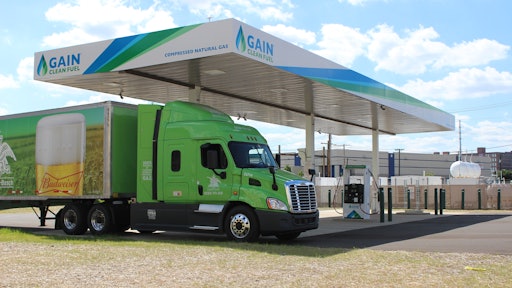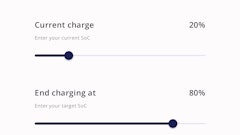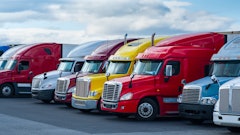
As more organizations commit to timebound sustainability goals, pressure continues to mount for the transportation industry to reduce greenhouse gas (GHG) emissions. After all, the transportation sector accounted for about 27% of total U.S. GHG emissions in 2020.
Federal guidance that defines how companies should measure their environmental impact suggests that regulatory and market pressure for efficient fleet services will continue. The Greenhouse Gas Protocol outlines three categories of emissions sources through which an organization’s carbon footprint can be quantified -- sources they own (Scope 1), sources they purchase or acquire from others (Scope 2) and sources within their value chain (Scope 3). Fleets that reduce their emissions in any of these categories can market themselves not only as a leader in sustainability but as a partner who can help reduce their customers’ Scope 3 emissions across the supply chain.
As a result, shippers and carriers are turning to alternative fuels to help reduce their emissions. Despite the need to transition, identifying the optimal path to decarbonize their fleet effectively (and affordably) can be overwhelming, especially since an overnight transition isn’t feasible. Unlike other shippers, the cold food and beverage supply chain will be especially conscious of technological changes because of their need to maintain cold environments and ensure product is delivered at peak freshness. The vehicles and refrigeration units that transport and store produce must run continuously, presenting an ideal scenario to target high emission generating segments.
But, where to start? Fleet managers can get off to a good start with a five-step approach that includes a diversified or polyfuel strategy. By identifying unique duty cycles, operational needs and decarbonization goals, fleet managers can successfully target environmental goals and economic performance simultaneously.
What is a polyfuel strategy?
A polyfuel strategy recognizes that multiple fuel types have a place in a long-term decarbonization plan. Instead of relying solely on one alternative fuel and transitioning a fleet all at once, organizations can identify what fuels will provide optimal performance for their fleets now and through the fleet’s transition. Using a combination of alternative fuels, such as renewable natural gas, electric, hydrogen and renewable diesel, fleets can gain a competitive edge.
Polyfuel strategies involve evaluating what fuel types work best for different transportation needs and then implementing the appropriate technologies for maximum fleet effectiveness. For example, an adaptive alternative fuel strategy may mean using one fuel source for return-to-base delivery and another for long-haul trucking. Similarly, vehicles operating in one state (such as California) may require more rigid emissions standards than vehicles in neighboring states.
5 steps to implement a polyfuel strategy
Industry leaders are already building polyfuel transition strategies that will facilitate the adoption of alternative fuels into their fleets. Specific to shippers and carriers, a polyfuel approach will enable them to make actionable progress on decarbonization goals while satisfying varying route requirements. Companies that want to join in this transition are encouraged to follow this approach:
1. Establish corporate commitments. Organizations should establish company-wide decarbonization commitments to streamline their transportation emission reductions. By identifying measurable objectives for all departments and documenting progress made, organizations will have a succinct, compelling sustainability story to share with external stakeholders.
2. Create a fleet baseline. Once an organization establishes a goal, fleet managers should create a fleet inventory and prepare for implementation, factoring in variables such as:
- The number of vehicles in their fleet
- Fleet capacity and the number of unique routes
- The quantity of fuel used
- The time of day and location where fueling must occur
- The time to educate employees who need to modify their day-to-day work and map out a rollout plan
3. Partner with trusted providers. Making sense of data and translating it into an actionable plan shouldn’t fall solely on fleet managers. Instead, organizations should:
- Partner with a transportation consulting firm that can help evaluate their data—taking into consideration business needs, markets, regulations (local, regional, state, or federal), clean fuel incentives, expansion goals, and performance metrics
- Engage with energy experts to help determine what alternative fuels are practical (and effective) for their fleet
4. Pilot alternative fuel technology. To ensure supply chain disruptions don’t occur and technology performs as expected, organizations can:
- Create a pilot project to test the impact (and effectiveness) of new technologies—documenting key learnings
- Provide actionable feedback for any improvements required after their pilot testing concludes
5. Scale up decarbonization commitments. To meet targeted decarbonization goals for the transportation industry, being able to scale adoption quickly is imperative. At the fleet level, if all employees participate in troubleshooting and measuring fleet performance accurately, new processes will be optimized and quality service will remain constant
Benefits of adopting alternative fuel vehicles
There are both environmental and business benefits for companies that adopt a polyfuel strategy. Lowering emissions now helps companies take a proactive approach to get ahead of future decarbonization regulations. Further, alternative fuel vehicles can experience a longer road life and require less maintenance than diesel trucks.
When a fleet reduces its emissions, it improves the carbon footprint for not only the fleet owners, but the customers as well. Because transportation influences companies’ carbon footprints, those that control their emissions can market themselves as a preferred partner to customers who have set their own sustainability goals. A recent McKinsey & Company article highlights that shippers are willing to pay a premium for sustainable transport offerings if key expectations are met; however, all parties need to work together for a long-term commitment that may include reshaping customer behavior, collaboration and supply chain emission transparency.
Polyfuel approach accommodates demand for electric vehicles
Organizations are making strides in reducing their fleet’s emissions footprint. Specifically, shippers are targeting their Scope 3 emissions, which positions them favorably with sustainably-driven carriers. Truck fleets are addressing their Scope 1 emissions by exploring existing financial incentives for alternative fuel trucks. Vehicle orders are being placed to comply with or prepare for fuel and technology directives/trends throughout the country. The current demand for electric trucks exceeds supply due to supply chain issues and demand growth.
As the industry waits to receive electric trucks, fleet managers might feel unable to take steps toward their decarbonization goals. However, there are aspects like people, processes, systems and technology that can be addressed today. Adopting a polyfuel strategy can guide decision-makers along that path.
Companies are building charging stations and planning operational changes for incoming electric trucks. Beyond the physical charging infrastructure, fleet maintenance, scheduling, capacity and routes may change based on vehicle range. It’s difficult to predict all the ways alternative fuels will change operations, but industry leaders are paving the way for a “greener” supply chain and more process efficiency in the future.
Find a transition strategy that supports your decarbonization journey
While electric vehicles may address many shippers’ decarbonization goals, neither vehicle manufacturers nor fleet managers are ready for overnight conversions. By implementing a multi-step approach that includes a polyfuel strategy, fleets can identify the right blend of alternative fuels to help bridge the gap and transition their fleets to the fuel solutions that are right for them.




























